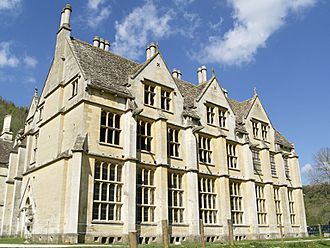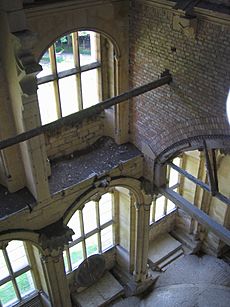Woodchester Mansion facts for kids
Quick facts for kids Woodchester Mansion |
|
|---|---|

View of the south front
|
|
| General information | |
| Architectural style | Gothic Revival |
| Location | Nympsfield, Gloucestershire, England |
| Construction started | 1858 |
| Completed | 1870 (partially) |
| Client | William Leigh |
| Technical details | |
| Structural system | Cotswold stone /vaulting |
| Design and construction | |
| Architect | Benjamin Bucknall |
Woodchester Mansion is a huge, unfinished house in Nympsfield, Gloucestershire, England. It looks like a castle from a fairy tale! This amazing building is designed in the Gothic Revival style, which means it looks like old medieval castles and cathedrals.
The mansion was built where an older house, called Spring Park, used to be. It's a very important historical building, protected by the government. What makes Woodchester Mansion so special is that it was never finished. Builders stopped working on it in the 1870s. From the outside, it looks complete, but inside, many rooms are missing floors, walls, and even ceilings! It has stayed this way for over 150 years.
The person who started building this mansion was William Leigh. He bought the land in 1854 for a lot of money. He then tore down the old house that was there. Today, about 200 greater horseshoe bats live in the mansion's attic. Scientists have been studying these bats since the 1950s!
Contents
The Mansion's Story: How It Began
The very first main house for the Woodchester area was in the village of Woodchester. After many different owners, the land was given to George Huntley in 1564. He decided to create a special park for deer, a bit away from the main house. He bought land and used common farming areas to make this park. A long wall, seven miles long, was built around the park. By 1610, a small hunting lodge was built at one end of it.
The Ducie Family and Spring Park
Making the deer park cost the Huntley family a lot of money. Because of this, they sold the land and park to Sir Robert Ducie in 1631. Later, the Ducie family decided to build a grand country house. They also wanted to turn the deer park into a beautiful landscaped garden. It's a bit of a mystery why they chose this spot. The valley sides are very steep, so the sun doesn't shine on the house for much of the year. Also, the house is halfway down the valley, which means the views aren't as grand as they could be from a higher spot. It wasn't easy to get to either.
Since it wasn't their main home, they might have wanted it as a quiet, hidden place. They decided to make the hunting lodge bigger and create a formal garden. The house, called Spring Park, was built in the 1740s. It was finished by 1750, and important people like Frederick, Prince of Wales and George III even visited!
Not long after the formal gardens were made, the Ducie family started changing the park again. They used plans from John Speyers and Capability Brown, a famous landscape designer. They removed the formal gardens to make the park look more natural. They also turned small fishponds into a series of lakes. This work happened in the late 1700s or early 1800s.
The house itself was also changed several times in the 1770s and 1830s. In 1840, the 2nd Earl Ducie wanted more changes, but the cost was too high. So, the estate was sold to William Leigh, a very rich merchant.
William Leigh's Dream House
William Leigh was born in Liverpool and went to famous schools like Oxford and Eton. When he bought Woodchester Park, he had recently become a Roman Catholic. At that time, the Gothic Revival style in architecture was very popular. This style, along with his faith, shaped his ideas for the new house. He first asked a famous architect named Augustus Pugin to draw plans.
Pugin made plans, but he became ill in 1846, and the project stopped for a while. Meanwhile, Leigh gave land in South Woodchester to a group of Catholic priests for a monastery and church. Then, he asked Charles Francis Hansom to take over the architectural plans. Hansom's brother designed the famous Hansom cabs used in Victorian London.
In 1857, Leigh made a surprising choice. He stopped working with Hansom and hired Benjamin Bucknall. Bucknall was a young, new architect who had been Hansom's assistant. He didn't have much experience. Bucknall spent time studying Gothic Revival architecture. The result, Woodchester Mansion, became Bucknall's most important work.
Building Woodchester Mansion started in 1858 and continued until 1870. In 1873, William Leigh passed away, and all work on the mansion stopped completely.
It seems Leigh's family wasn't as excited about the mansion's design. Soon after he died, they asked another architect, James Wilson, to suggest a new design. Wilson proposed a fancy Italianate style, but building a whole new mansion would have been too expensive. This shows they didn't share their father's passion for the Gothic style. Wilson also thought the location was not good. He wanted them to build in a different part of the valley if they were going to continue.
Wilson wrote that the location was "low, damp, and has much shut-in on the south, west and north." He felt that the nearby high bank would always make the house damp.
Meanwhile, Bucknall moved to Algiers. We don't know exactly why he moved, but he must have been very sad that his grand building was left unfinished. In 1878, he wrote to Leigh's son, saying that "there is nothing more sad to the sight than an unfinished work."
In 1894, Cardinal Vaughan visited the house, and the drawing room was updated. But after that, the house was often empty. The next owner, Vincent Leigh, lived in a small part of the house, and his sisters lived in the gatehouse.
The 20th Century and Beyond
In 1938, William Leigh's granddaughters, Blanche and Beatrice, sold the house and what was left of the land. They sold it to a charity that helped people with mental health, called the Barnwood House Trust. The charity planned to turn the mansion into a hospital, but this idea was later dropped.
During the Second World War, the land around the mansion was used by Canadian and American soldiers. The mansion itself was used by a teacher training college. After the war, it was left empty and open to the weather. Luckily, because it was in an isolated spot, it wasn't damaged by vandals. It also wasn't torn down or rebuilt.
Local people helped make sure the mansion didn't fall apart completely. Eventually, Stroud District Council bought the mansion and a small area of land around it. In 1992, they leased it to a group called the Woodchester Mansion Trust. This trust works to restore the mansion and open it to the public.
The mansion is open to visitors from April 1 to October 31, on Fridays, Saturdays, Sundays, and Bank Holiday Mondays. Volunteers help manage the mansion and welcome visitors. The Trust also offers training courses to teach people how to repair old stone buildings.
Woodchester Park: Exploring the Outdoors
The beautiful parkland around Woodchester Mansion is owned by the National Trust. It is open to everyone as part of Woodchester Park. This park has several other interesting buildings. These include a gatehouse, a boathouse, some small cottages, and an ice house (a building used to store ice before refrigerators existed). There are also several large lakes with many paths for walking through the fields and woods. A lot of the nearby Woodchester village used to be part of Woodchester Park.
You can enter the park for free. There's a National Trust car park near the entrance where you pay to park. This car park is at the western end of the park, off the B4066 road. Toilets for mansion visitors are located near the mansion and are open when the mansion is open. There is a fee to enter the mansion itself.
Woodchester Mansion on Screen
Woodchester Mansion has appeared in several television shows. These include:
- The BBC wildlife series Naturewatch in 1982.
- ITV's Magick Eve in 2003.
- A 2006 BBC show called Dracula.
- The second season of The Crown.
- Many shows about paranormal activities.



